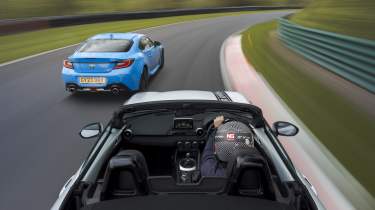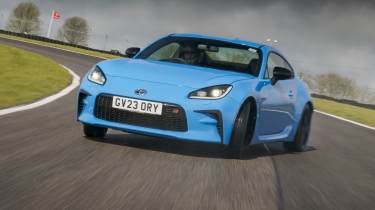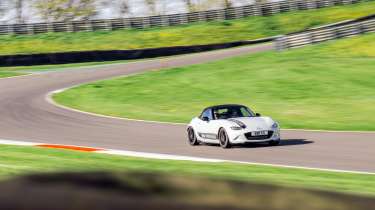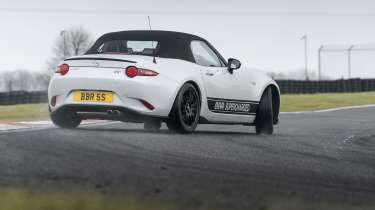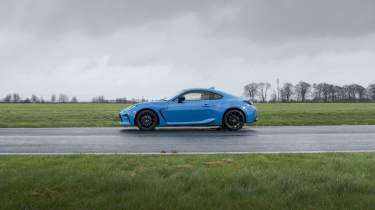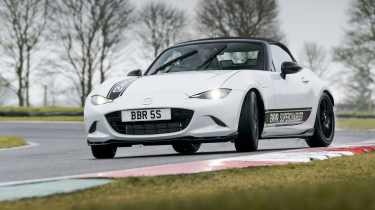Toyota GR86 v BBR Mazda MX-5: supercharged drop-top battles sports coupe
The excellent Toyota GR86 and BBR's supercharged MX–5 look closely matched on paper; how will it prove on the twists and undulations of Cadwell?
If a hot hatch represents the most accessible entry point to trackday driving, the simple front-engined rear-drive sports car is the next rung up the ladder. Not necessarily in terms of outright speed around a lap, but very much as a way of developing your driving skills and enjoying the endless fun of steering a car on the throttle.
The GR86 and MX‑5 make a great pair. Both are evo favourites and each occupies the sweet spot where your daily driver can double as something for weekend fun or the occasional trackday. The Toyota here is bone-stock while the MX‑5 is a BBR-modified example, so it’s not quite like-for-like, but the comparison should be fascinating with very little to choose between them.
> Toyota GT86 v GR86: how Toyota perfected the affordable sports car
Each offers similar on-paper performance via somewhat different routes. Toyota’s naturally aspirated 231bhp 2.4-litre flat-four offers 231bhp and 184lb ft of torque, while the Mazda’s 2-litre in-line four gains a Rotrex supercharger and free-flow manifold and exhaust system to make 250bhp and 220lb ft.
Small and light by ‘proper’ road car standards, the GR86 weighs in at 1309kg on Cadwell’s scales, the MX‑5 a flyweight 1084kg (both with a full tank of fuel). When it comes to weight distribution the Mazda is 46:54 front-to-rear, while the Toyota flips that with a 55:45 balance.
We start with the GR86. While it’s easy to be seduced by the more hardcore contenders from our TCoty test in issue 322, there’s much to be said for something with modest power and easy-to-read handling. While the lairy metal is best left in the paddock when it’s raining, the Toyota is in its element, slithering and sliding around and coping with standing water with little of the jeopardy that comes with taming big power and stiff suspension in dicey conditions.
More reviews
The GR is equally up for it in the dry. John Barker is certainly a fan: ‘It’s just enough for around here – you can get late-corner oversteer out of Charlie’s, which you can feel coming and gather up easily thanks to the car’s dynamic transparency and inherent poise. You can take the brakes right to the apex, feel the level of grip and be accurate, and it’s pretty good at direction changes too.’
Mazda’s evergreen sports car gets a lot of stick from certain quarters for not being macho enough, but this BBR Stage 2 car looks and sounds like a little bruiser. The conversion encompasses engine, chassis (including wheels and tyres) and brakes, and totals around £12,000 including VAT and fitting.
Those tweaks give the MX‑5 more attitude than the GR. It sounds sharper and looks more purposeful but still feels very much a road car with upgrades rather than a full-blown track car. You sit low and sense its compactness; like the GR it makes Cadwell feel usefully wider than, say, the broader BMWs, and the low weight means you have the freedom to drive without being punished by momentum, with mistakes or over-exuberance quickly gathered up.
The engine is much nicer than the Toyota’s, sweeter and keener to spin than the flat-four, which sounds strained at high revs. You notice the torque (and weight) advantage out of the tighter corners, and especially along the undulating Park Straight, but peak speeds are very close, the GR hitting 111.8mph against the MX‑5’s 112.8.
Where the GR is a little less grippy but more fluid, the Mazda is sharper but less together, the front end’s initial response slightly out of sync with the rear end’s capacity to follow. As a result it takes a split-second longer to settle, especially into the faster corners, something revealed by corner speeds that consistently see the GR carry a few more mph on turn-in – 95.3mph v 93mph at Coppice and 71.6mph v 69.6mph in the middle of the Gooseneck.
The exception is Hall Bends, where the MX‑5’s minimum speed is 59mph to the GR’s 57.7mph. We put this down to the MX‑5’s compactness making it easier to take a cleaner line through this narrow and confined section of the lap, and the whopping 225kg weight advantage, surely a big help through the repeated rapid direction changes.
Apart from price – BBR has a similar spec and age MX‑5s for sale at around £22k – there’s very little to choose between the pair. As Barker says: ‘The MX‑5 has a little more grip and a little more power than the GR – you really notice heading up the hill to Park. It also oversteers mildly in all the same places but is a fraction less consistent, not quite as well balanced; it’ll understeer a little at the hairpin, for instance. You can still have great fun, though.’
When it comes to the timed laps – in which the MX‑5 pips the GR by just 0.5sec – neither car feels entirely happy. The Toyota is initially neat and fun, but quickly overworks its rear tyres. Then the fronts lose their bite and it gets harder to nail your braking points. You end up reacting to contain unwanted slides – sometimes understeer, sometimes oversteer – and generally feeling increasingly ragged. Better to work yourself and the car less hard, stick at eight or nine tenths and just enjoy the laps.
The Mazda has similar consistency issues, but it’s a fraction spikier when it does let go. Maximum attack amplifies the lack of unison between front and rear, so it’s harder to walk the line between full commitment and over-driving. A little bit of set-up work to get the front end dialled in would make all the difference. The brakes – featuring BBR’s four-piston Wilwood caliper upgrade – also began to struggle during the timed laps. BBR also offers a six-piston upgrade and track pads, which should be more suited to hard track use, though larger discs would be a better solution if you get serious.
Like JB, I have a soft spot for both cars. I’ve always admired the ND-gen MX‑5 for its purity and simplicity. Hats off to Mazda for still building a two-seater rear-drive sports car that weighs a little over a ton. I also like the idea of considered tuning modifications that add performance and intensify the experience without fundamentally altering the character and capabilities of the car.
The GR86 is similarly appealing. As a road car it is greatly improved compared to the GT86, which was hobbled by horrid ‘eco’ tyres and a gutless engine. It’s also a genuinely entertaining track car, with enough performance to be fun and sufficient poise to please skilled hands or encourage those with less experience. Few cars offer more versatile fun.
This story was first featured in evo issue 322.
